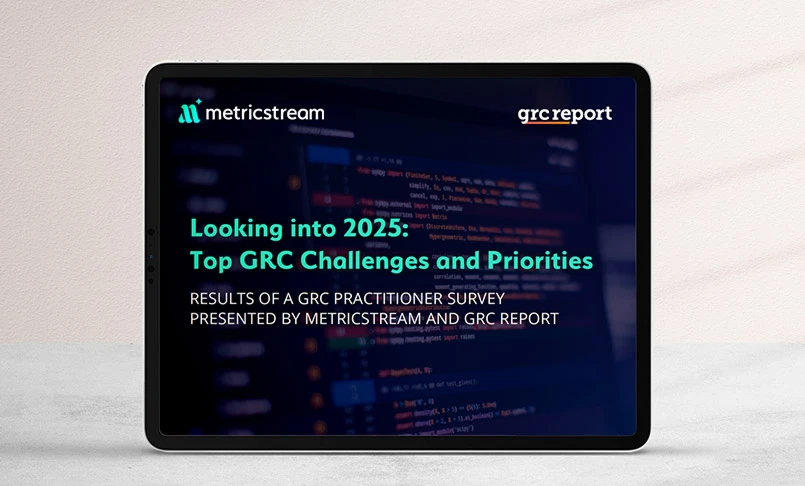AI in GRC: Your Top FAQs Answered
- 04 June 25
Introduction
In today's rapidly evolving digital landscape, Governance, Risk, and Compliance (GRC) functions are under increasing pressure to manage complex regulatory requirements, emerging interconnected risks, and vast amounts of data. Traditional methods often fall short in providing the agility and precision needed. Artificial Intelligence (AI) has emerged as a transformative force, offering advanced capabilities to enhance decision-making, automate processes, and proactively manage risks. Integrating AI into GRC is now necessary for organizations aiming to stay ahead in a dynamic environment.
What is AI in GRC?
AI in GRC refers to the application of artificial intelligence technologies, such as agentic AI, generative AI, machine learning (ML), natural language processing (NLP), and predictive analytics, to automate and enhance governance, risk management, and compliance processes. These technologies enable organizations to analyze large datasets, identify patterns, predict potential issues, and make informed decisions.
Key AI Technologies in GRC
AI technologies transforming the GRC space range from machine learning, natural language processing, automation, and data analytics tools. Here's a concise breakdown of the most impactful ones:
- GRC co-pilots: These AI-powered assistants are designed to help GRC professionals navigate complex risk and compliance tasks with greater ease. They can quickly answer regulatory questions, draft new policies, and even analyze control effectiveness.
- Multi-agent systems (MAS): Consisting of multiple AI agents working together, MAS brings a new dimension to GRC. Each autonomous agent can focus on a specific task such as monitoring regulatory changes or tracking risk signals—and then share findings with others to build a more holistic risk picture. This distributed intelligence model allows for faster decision-making.
- Large language models (LLMs): LLMs use natural language processing to turn static information into dynamic intelligence. They can interpret regulations, analyze policies, and surface control gaps. They also support real-time monitoring and predictive analytics, helping organizations stay ahead of emerging threats.
- Machine Learning (ML): Learns from historical data to predict future risks and compliance issues.
- Natural Language Processing (NLP): Analyzes unstructured data, such as regulatory texts and contracts, to extract relevant information.
- Predictive Analytics: Forecasts potential risks and compliance breaches before they occur.
AI in Risk Management: From Reactive to Predictive
Traditional risk management often relies on historical data and periodic assessments, which can delay the identification of emerging risks. AI shifts this paradigm by enabling continuous risk assessment and predictive analytics.
Applications:
- Risk Scoring: AI models assess and assign risk scores to various factors, enabling prioritization.
- Anomaly Detection: Identifies unusual patterns that may indicate potential risks.
- Real-Time Monitoring: Continuously monitors data to detect and respond to risks promptly.
According to a recent study by the German Institute for Economic Research, AI increased the prediction accuracy of European Central Bank monetary policy decisions from roughly 70 percent to 80 percent.
AI in Compliance: Automating the Burden
Compliance departments are often overwhelmed by manual processes such as documentation, monitoring, and regulatory interpretation, which are time-consuming and prone to human error. AI addresses this issue by introducing intelligent automation into every step of the compliance workflow.
- Continuous Controls
Testing AI can automatically and continuously test controls across systems, detecting control failures or exceptions in near real-time. This reduces the dependency on periodic assessments and helps organizations proactively address gaps before they become compliance breaches. - Regulatory Change Management
Using NLP (Natural Language Processing), AI tools can scan thousands of regulatory websites, government updates, and legal documents daily. These tools interpret complex legal language, categorize updates by relevance, and even recommend changes to internal policies or procedures to maintain compliance. - Accuracy and Speed
AI minimizes the need for manual data entry and reconciliation, reducing error rates significantly. Automated systems can process vast volumes of data in minutes, tasks that might otherwise take days or weeks for human teams. This increases efficiency and ensures compliance reports are delivered faster and with greater precision.
AI in Audit: Enhancing Internal Auditing with Intelligence
AI minimizes the need for manual data entry and reconciliation, reducing error rates significantly. Automated systems can process vast volumes of data in minutes, tasks that might otherwise take days or weeks for human teams. This increases efficiency and ensures compliance reports are delivered faster and with greater precision.
- AI in Audit: Enhancing Internal Auditing with Intelligence
Internal audit plays a key role in assessing organizational integrity, but the traditional audit process is often retrospective and labor-intensive. AI brings proactive intelligence to auditing, transforming it from a point-in-time function to a continuous and predictive activity. - Risk-Based Auditing
AI models can identify patterns and anomalies that indicate high-risk areas by analyzing historical audit data, financial transactions, and operational metrics. This enables auditors to allocate resources effectively and focus on the most critical issues, improving audit outcomes. - Continuous Auditing
With AI, organizations can implement always-on audit mechanisms that continuously evaluate financial records, operational processes, and control effectiveness. This ensures early detection of irregularities and allows for real-time remediation, rather than relying solely on annual or quarterly reviews. - Enhanced Insights
AI tools can analyze structured and unstructured data to uncover relationships or trends that are not immediately visible. For example, AI can flag unusual supplier transactions that may suggest fraud or uncover systemic weaknesses in internal controls that need remediation.
AI in IT and Cyber Risk Management
As cyber threats become more advanced, traditional rule-based security tools struggle to keep up. AI enhances cyber risk and security efforts by enabling proactive threat identification and intelligent response mechanisms.
- Anomaly Detection
Machine learning algorithms can be trained to understand the baseline behavior of users, devices, and networks. When deviations from this baseline are detected, such as an employee accessing sensitive files at odd hours, AI can instantly flag them for review or even initiate automated response protocols. - Threat Intelligence
AI can pull data from threat intelligence platforms, dark web monitoring, firewall logs, and security incident reports to comprehensively view the threat landscape. It can predict attack vectors and vulnerabilities specific to an organization’s tech stack, helping teams prioritize defensive actions. - Reduced False Positives
One of the major challenges in cybersecurity is alert fatigue. AI helps refine detection models to reduce the number of false alarms by learning from past incidents and tuning its detection logic. This enables security analysts to focus on real threats instead of wasting time on benign alerts - Case in Point
AI systems can reduce the volume of alerts presented to analysts by 61% over six months, maintaining a low false negative rate of 1.36%.
AI in Third-Party Risk Management
Third-party vendors, suppliers, and partners can be a major source of risk, from data breaches to compliance violations. AI simplifies and strengthens third-party risk management (TPRM) by automating assessments and enabling continuous oversight.
- Automated Onboarding
AI can collect and analyze vendor information from multiple sources, including financial statements, public records, and social media. It automates due diligence by generating real-time risk scores, identifying red flags such as prior compliance issues or financial instability, and helping procurement teams make more informed decisions. - Continuous Monitoring
Once a third party is onboarded, AI continuously scans for changes in risk status, such as negative news mentions, legal actions, or data breaches. This ensures that risk isn’t only assessed once during onboarding but is actively monitored throughout the vendor relationship. - Predictive Risk Assessment
AI analyzes historical and contextual data to forecast potential risks before they materialize. For example, if a vendor’s delivery times are increasingly erratic and employee turnover is rising, AI may flag them as a supply chain risk even before a disruption occurs.
The Benefits of AI in GRC
AI’s application in GRC leads to transformative benefits that go beyond automation. It enables organizations to be more proactive, data-driven, and resilient
- Increased Efficiency
AI takes over time-intensive, repetitive tasks such as document review, risk scoring, and control monitoring, allowing teams to redirect their efforts toward strategy, investigation, and stakeholder engagement. - Enhanced Accuracy
Human error is a frequent cause of compliance lapses. AI reduces this risk by applying consistent rules and logic, especially when dealing with complex or high-volume data sets. This results in more reliable outcomes across GRC. - Real-Time Insights
Instead of relying on outdated reports or lagging indicators, AI provides real-time dashboards and alerts. This empowers leadership with the situational awareness needed to act swiftly on emerging risks or compliance breaches. - Scalability
Whether a company is growing its operations, entering new markets, or facing more stringent regulatory environments, AI systems scale effortlessly. They handle increased data volumes and complexity without requiring proportionate increases in human resources.
Challenges and Risks of AI in GRC
Despite its advantages, organizations must be aware of the challenges associated with implementing AI in GRC functions.
- Data Quality
AI is only as good as the data it’s trained on. Incomplete, inconsistent, or biased data can lead to inaccurate risk predictions or faulty compliance recommendations, undermining the very benefits AI is supposed to deliver. - Integration Issues
Integrating AI with legacy systems or siloed data sources can be technically challenging and resource intensive. Without seamless integration, AI tools may not function optimally or provide holistic insights. - Ethical Concerns
There is a growing concern around algorithmic bias in AI systems, especially when used in sensitive areas like compliance enforcement or audit decisions. Organizations must ensure fairness, transparency, and accountability in their AI models. - Regulatory Uncertainty
Governments and regulators are still defining policies around AI use. Organizations using AI in GRC must navigate ambiguous guidelines and may need to defend their use of algorithms in audits or legal disputes.
The Future of AI in GRC
The integration of AI into GRC is set to deepen over the coming years. Emerging technologies like Generative AI, Explainable AI (XAI), and Agentic AI are at the forefront, shaping how organizations manage risk, ensure compliance, and build transparency in decision-making processes.
Generative AI
Generative AI, best known for creating human-like text, images, and simulations, is rapidly finding applications in the GRC space. It can automate the drafting of internal policies and compliance documentation based on historical data, regulatory requirements, and industry best practices. This reduces manual effort and ensures consistency across documentation.
Moreover, generative models can simulate risk scenarios by analyzing a range of variables such as economic conditions, geopolitical shifts, or internal control failures. These simulations help decision-makers visualize the potential outcomes of different risk events, enabling more strategic planning and response. Generative AI also accelerates incident reporting, converting raw event data into narrative summaries or dashboards tailored for auditors, executives, or regulators.
Explainable AI (XAI)
As AI models used in GRC become increasingly complex, the need for transparency in how these models arrive at decisions becomes critical. This is where Explainable AI (XAI) plays a vital role.
XAI allows users to understand, trust, and validate the decisions made by AI systems. In a GRC context, this could mean providing a clear rationale for why a particular transaction was flagged as risky or how a vendor received a specific risk score. Regulators are increasingly demanding audit trails for AI decisions, especially in sectors like finance, healthcare, and public services.
By making black-box models more interpretable, XAI helps organizations demonstrate compliance with AI ethics, data governance, and fairness standards. It also fosters greater internal adoption, as risk and compliance teams can act on AI-driven recommendations more confidently.
Agentic AI
Agentic AI represents the next frontier in AI's role within GRC. Unlike traditional AI, which operates on predefined instructions, agentic AI systems exhibit a higher degree of autonomy. These systems can set goals, make decisions, learn from outcomes, and adapt their behavior over time — essentially functioning like intelligent agents within an organization.
In GRC, Agentic AI can autonomously monitor compliance obligations, detect emerging risks, and trigger appropriate workflows without human initiation. For example, an agentic AI could continuously scan regulatory updates, cross-reference them with company policies, and initiate updates or alerts to relevant departments. It could also proactively engage with vendors or stakeholders to gather compliance documents or conduct ongoing due diligence checks.
However, Agentic AI also raises new challenges around governance and control. Organizations must carefully define the scope of these agents, establish ethical boundaries, and ensure that autonomous decisions align with both regulatory expectations and internal values.
Best Practices for Implementing AI in GRC
To effectively integrate AI into GRC frameworks, organizations must take a strategic and structured approach. These best practices ensure AI initiatives are not only technically sound but also ethically and operationally robust.
Establish a Robust Data Foundation
AI is only as good as the data it learns from. Organizations must invest in high-quality, well-structured, and compliant datasets. This includes:- Establishing data governance policies to manage the data lifecycle, lineage, and ownership.
- Data cleaning and normalization techniques are used to ensure consistency across systems.
- Creating centralized, secure data lakes or warehouses where GRC-related information can be accessed in real time by AI tools.
Without clean and governed data, AI models risk perpetuating bias or making inaccurate predictions that can compromise compliance or risk posture.
Select Appropriate Tools and Vendors
Not all AI tools are built for GRC use. It’s critical to:- Evaluate vendor transparency, especially how their models make decisions and whether their algorithms are explainable.
- Prioritize tools that offer industry-specific capabilities (e.g., financial regulatory mapping, supply chain risk scoring, etc.).
- Consider integration capabilities with existing systems like GRC platforms, ERP, or cybersecurity tools.
Look for vendors that also offer ongoing model monitoring and support for compliance with evolving regulations such as the EU AI Act or the U.S. AI Executive Order.
- Implement AI Governance
AI governance ensures that AI systems operate within defined ethical and legal boundaries. This involves:- Creating a cross-functional AI ethics board that includes legal, compliance, IT, and business leaders.
- Defining acceptable use policies for AI, especially regarding sensitive data and decision-making in high-risk areas.
- Setting up regular audits of AI models to assess performance drift, bias, and adherence to compliance controls.
Train and Empower GRC Teams
AI isn’t a replacement; it’s a partner. To ensure adoption and effectiveness:- Train staff on how AI models work, including interpreting outputs and identifying anomalies.
- Encourage human-AI collaboration, where domain experts guide and validate AI-driven insights.
- Foster a culture of continuous learning, offering certifications or workshops on ethical AI, data science for compliance, or automation tools.
Well-trained teams are more likely to trust and effectively leverage AI in complex regulatory scenarios, rather than viewing it as a black-box solution.
Real-World AI in GRC Use Cases
Organizations across a wide range of sectors are adopting AI to strengthen their GRC programs in innovative ways:
AI Use Cases in GRC Across Key Risk Domains
Organizations across industries are embedding AI into their GRC frameworks to manage risks more proactively and intelligently. Here’s how AI is making a measurable impact across four critical risk domains:
Audit Risk
AI is streamlining internal audit functions by automating control testing, identifying anomalies in large datasets, and improving audit coverage. Instead of relying on periodic sampling, organizations are deploying AI to continuously monitor transactions and flag irregularities in real time. These systems can also prioritize audit areas based on risk scores, enabling teams to focus on high-risk business functions and optimize audit planning.
Use Case: An enterprise risk team uses AI to analyze finance, HR, and operations data, detecting policy breaches and deviations from expected patterns. The result is a dynamic audit plan that evolves based on emerging risks and real-time findings.
Cyber Risk
AI helps organizations strengthen cybersecurity postures by monitoring networks for threats, detecting unusual user behavior, and predicting potential attack vectors before breaches occur. Machine learning models can analyze billions of log entries to surface potential vulnerabilities that human teams might miss.
Use Case: A healthcare provider uses AI for continuous threat detection, spotting unauthorized access attempts and alerting IT teams before sensitive data is compromised, ensuring better compliance with data protection regulations.
Third-Party Risk AI is being used to assess and monitor third-party risk more effectively. By analyzing vendor behavior, financial health, and geopolitical indicators, AI systems can flag partners who pose a compliance, operational, or reputational threat. Natural Language Processing (NLP) tools also parse through thousands of news articles, social media posts, and regulatory databases to surface risks from vendors in real time.
Use Case: A retail company leverages AI to track vendor compliance with labor, environmental, and data privacy standards across multiple countries. This ensures ongoing adherence to policies without overloading internal teams.
Enterprise Risk
At the enterprise level, AI models are supporting scenario analysis, risk forecasting, and strategic decision-making. AI can simulate economic, operational, and environmental stress events, allowing organizations to assess potential impacts and build contingency plans. These tools also integrate with business performance systems, providing leadership with real-time insights into risk exposure.
Use Case: A manufacturing conglomerate uses AI to forecast supply chain disruptions and simulate how different risk events — like regulatory changes or geopolitical unrest—might affect business continuity across global operations.
By embedding AI into these core areas of GRC, organizations are not only becoming more agile and resilient but also creating a more intelligent, proactive approach to risk and compliance management.
Embrace the AI in GRC Opportunity with MetricStream
The integration of AI into GRC is not just a technological upgrade but a strategic imperative. By embracing AI, organizations can achieve greater efficiency, proactive risk management, and enhanced compliance. However, this requires thoughtful implementation, continuous monitoring, and a commitment to ethical practices.
MetricStream’s AI-first Connected GRC suite of products, including Risk, Compliance, Audit, Cyber GRC, Third-Party Risk and Resilience, are designed to streamline and automate end-to-end GRC processes for optimal efficiency.
With our agentic and generative AI capabilities, organizations can easily mitigate risks, ensure compliance, navigate audits, and drive resilience. Tedious tasks are automated by AI agents, freeing up more time for what truly matters. Stakeholders can focus on protecting and growing the business with the security and privacy they expect, since we never share or use organizational data to train third-party AI.
Using MetricStream, organizations can:
- Strengthen operational resilience with a unified platform for operational risk, cyber risk, compliance risk, third-party risk, and business continuity management
- Streamline regulatory compliance, while staying on top of regulatory changes and updates
- Proactively identify, manage, and mitigate third-party risks with AI-powered automation and a complete view of the extended enterprise
- Keep cyber risks in check with built-in best practice frameworks and controls, as well as advanced cyber risk quantification capabilities
- Simplify audits through a centralized, risk-based approach
- Effectively manage environmental, social, and governance (ESG) risks with streamlined tracking, real-time reporting, and alignment to global standards
Unlock the power of AI-first Connected GRC with MetricStream. 
FAQs
What is AI in GRC?
AI in GRC refers to the application of artificial intelligence technologies to enhance governance, risk management, and compliance processes, enabling more efficient and proactive decision-making.
How is AI used in risk management?
AI is utilized in risk management to analyze large datasets, identify potential risks through predictive analytics, and automate monitoring processes for real-time risk assessment.
Can AI replace compliance officers?
While AI can automate routine compliance tasks, it serves as a tool to augment the capabilities of compliance officers rather than replace them, allowing professionals to focus on strategic decision-making.
What are the risks of using AI in audit?
Risks include potential biases in AI algorithms, lack of transparency in decision-making processes, and over-reliance on automated systems without human oversight.
Is AI used in third-party risk assessments?
Yes, AI is increasingly used to evaluate third-party risks by analyzing vendor data, monitoring compliance, and predicting potential issues, thereby enhancing the efficiency of risk assessments.






